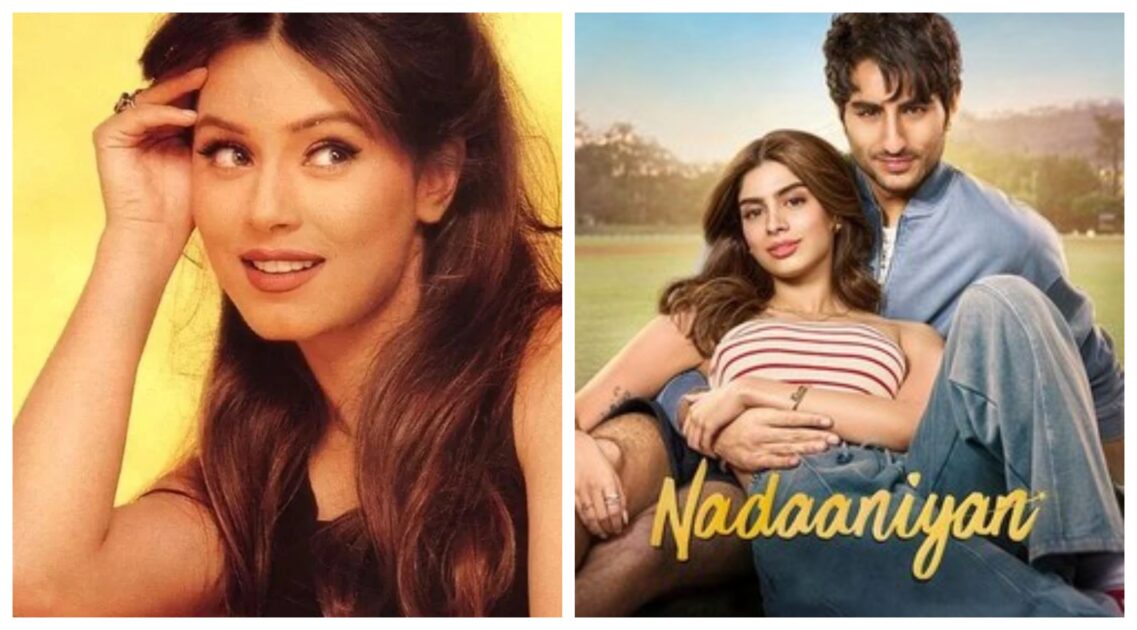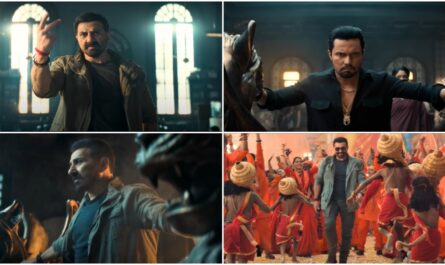In the world of Bollywood, where stardom meets relentless media scrutiny, veteran actress Mahima Chaudhry has never been one to shy away from defending her work and beliefs. Recently, Chaudhry made headlines by vocally defending the film Nadaaniyan amid a barrage of criticism. In a statement that resonated with many, she went further to draw a parallel between the criticisms aimed at Nadaaniyan and those directed at Ranbir Kapoor’s film Animal. This article delves deep into Chaudhry’s defense, examines the broader context of film criticism in Bollywood, and unpacks the conversation around media bias and double standards that have long plagued the industry.
A Storied Career and an Unyielding Spirit
Mahima Chaudhry burst onto the Bollywood scene in the mid-1990s, capturing audiences with her performance in films such as Pardes and Dil Ka Rishta. Her journey in the film industry has been marked by both critical acclaim and occasional controversies, making her a figure who understands the complexities of media narratives. Over the years, Chaudhry has evolved from being perceived as a glamorous actress to a mature, thoughtful critic of industry practices. Her forthright nature and willingness to address issues head-on have earned her respect from many corners of the film fraternity.
Chaudhry’s recent defense of Nadaaniyan is consistent with her long-held belief in artistic integrity. By standing up against what she sees as unjust criticism, she not only defends her own work but also speaks to a broader systemic issue within Bollywood—the tendency to single out certain films or artists based on pre-existing biases or inconsistent standards.
The Controversy Surrounding Nadaaniyan
Nadaaniyan—a film that has sparked as much debate as it has intrigue—has been the subject of intense scrutiny. Critics have questioned everything from the film’s narrative choices to its overall execution, often highlighting perceived shortcomings that, in their view, detract from its cinematic value. However, what has become increasingly evident is that the criticism does not exist in a vacuum. Instead, it is intertwined with larger narratives about gender, star power, and the evolving tastes of audiences.
Chaudhry argues that the negative commentary aimed at Nadaaniyan is not merely a reflection of the film’s artistic choices. Rather, it is symptomatic of a media environment that sometimes operates under a double standard—where similar creative risks or narrative decisions in films starring other actors receive a far more forgiving reception. By defending Nadaaniyan, Chaudhry highlights a perceived hypocrisy within the film criticism circuit that too often targets certain projects while excusing others.
Drawing Parallels: Nadaaniyan and Animal
In her recent comments, Mahima Chaudhry made a striking comparison between the criticism of Nadaaniyan and the negative responses faced by Ranbir Kapoor’s Animal. Ranbir Kapoor, known for his eclectic film choices and magnetic screen presence, has also experienced his share of media backlash, particularly with films that push the boundaries of conventional Bollywood narratives. Chaudhry’s comparison is deliberate and pointed: she suggests that if Animal—a film featuring a male superstar known for his versatility—can face harsh criticism despite its innovative elements, then Nadaaniyan, too, deserves a more balanced and fair evaluation.
This comparison is not just about defending one film over another; it is about challenging the very framework of film criticism in Bollywood. Chaudhry’s comments invite a reassessment of the criteria used by critics and audiences alike. Are films judged solely on their merits, or do factors like star power, gender, and even the personal narratives of those involved unduly influence the critique? By linking the two films, Chaudhry raises an important question: why is it that some films are given a pass on creative experimentation while others are harshly criticized for taking similar risks?
The Double Standard in Film Criticism
One of the central themes emerging from this controversy is the issue of double standards in film criticism. Historically, Bollywood has witnessed instances where films starring male leads or backed by certain production houses have been allowed more creative leeway, whereas films featuring women or unconventional narratives often find themselves under a stricter microscope.
The Role of Gender and Stardom
Bollywood’s storytelling and promotional machinery have long been dominated by certain archetypes. Male actors, especially those with a reputation for choosing diverse roles, are often celebrated for their bold choices even when those choices result in films that defy traditional commercial formulas. On the other hand, films featuring actresses or challenging traditional narratives are sometimes met with skepticism. Chaudhry’s defense of Nadaaniyan can be seen as an effort to push back against this ingrained bias.
Moreover, the way media frames criticism is often reflective of broader societal attitudes. In many cases, female artists are scrutinized not just for their work but for their personal lives, choices, and even their looks. Chaudhry’s rebuttal thus becomes more than a defense of a single film—it becomes a statement against a culture that tends to undervalue and misinterpret the creative contributions of women in the industry.
Creative Risks and Audience Expectations
Another layer to the discussion is the nature of creative risks in contemporary cinema. In an era where audiences are increasingly seeking innovation, filmmakers are compelled to experiment with narrative structures, genre blends, and unconventional storytelling techniques. While these experiments often lead to groundbreaking cinema, they can also result in polarized opinions. Critics who are steeped in traditional cinematic paradigms may resist acknowledging the evolution of storytelling, thereby penalizing films that do not conform to established norms.
Chaudhry’s reference to Animal—a film that itself has been a subject of debate—underscores this tension. By drawing a parallel between the two films, she emphasizes that criticism should be rooted in an honest evaluation of creative risks rather than in a predisposition to favor the familiar. It is a call to both critics and audiences to embrace a more progressive outlook on cinema, one that celebrates innovation even when it challenges conventional tastes.
The Impact on Industry and Public Discourse
The conversation sparked by Mahima Chaudhry’s defense of Nadaaniyan has broader implications for Bollywood. When prominent figures in the industry speak out against what they perceive as unfair treatment, it encourages a more reflective and self-critical media landscape. This, in turn, can lead to a gradual shift in how films are evaluated and discussed publicly.
Media Narratives and Social Media Backlash
In today’s digital age, film criticism is no longer confined to traditional print media or televised reviews. Social media platforms have democratized the process, allowing fans and critics alike to voice their opinions in real time. However, this democratization has its pitfalls. The rapid spread of opinions can sometimes lead to echo chambers where certain viewpoints are amplified while others are marginalized.
Chaudhry’s comments have resonated on platforms like Twitter and Instagram, where fans have joined the conversation to express their support or dissent. The comparison to Animal has particularly struck a chord with those who have observed similar patterns of biased criticism across different films. This digital dialogue has not only amplified Chaudhry’s voice but also forced industry insiders and critics to reconsider the metrics they use to assess a film’s worth.
The Role of Influential Voices in Shaping Opinions
When a veteran actress of Chaudhry’s stature speaks out, her words carry weight. Her perspective is informed by years of navigating the turbulent waters of Bollywood, and her critique of the media’s double standards is seen as both timely and necessary. In defending Nadaaniyan, Chaudhry is not merely advocating for a single film but is championing the cause of fair criticism across the board.
The impact of her defense is twofold. Firstly, it provides solace to filmmakers and actors who feel that their work is being judged unfairly due to external biases. Secondly, it challenges critics to re-examine their own standards and perhaps adopt a more nuanced approach when reviewing films that push creative boundaries. In essence, Chaudhry’s stance is a call for a more empathetic and comprehensive understanding of art—one that values intent, innovation, and context as much as technical execution.
Broader Implications for Bollywood’s Future
The debate around Nadaaniyan and Animal is symptomatic of larger changes in the Bollywood industry. With audiences becoming more sophisticated and diverse in their tastes, there is an increasing demand for films that are both entertaining and thought-provoking. This shift necessitates a corresponding change in how films are critiqued and discussed.
Embracing Diversity in Storytelling
Bollywood is at a crossroads where the traditional formula of song, dance, and melodrama is gradually giving way to narratives that are more realistic, gritty, and reflective of contemporary society. Films are increasingly exploring complex themes such as social inequality, mental health, and identity politics. In this evolving landscape, the old benchmarks of film criticism may no longer be adequate.
By defending Nadaaniyan and comparing its treatment to that of Animal, Chaudhry is urging the industry to adopt a more flexible approach. It is a reminder that cinema is an art form that thrives on diversity—diversity not only in terms of narrative but also in the voices that contribute to its critique. A more inclusive approach to criticism could lead to richer, more layered discussions about films and, ultimately, to a more vibrant cinematic culture.
The Need for Constructive Criticism
Criticism, when done constructively, can be a powerful tool for improvement. However, when criticism is steeped in bias or influenced by external factors such as star power or gender, it loses its value. Chaudhry’s defense of Nadaaniyan is also a plea for more constructive, balanced, and objective criticism in Bollywood.
Constructive criticism involves recognizing the merits of a film while also offering insights into areas that might need refinement. It is about engaging with the work on its own terms, rather than through the lens of preconceived notions or industry politics. As the Bollywood industry continues to evolve, the voices of critics—both seasoned professionals and new-age bloggers—must rise to the challenge of evaluating films in a manner that is both fair and forward-looking.
Reflections on Media Bias and the Future of Film Criticism
The controversy surrounding Nadaaniyan and Animal serves as a microcosm of a much larger issue—the inherent bias that can sometimes color film criticism. Whether it’s the undue scrutiny faced by films helmed by women or the preferential treatment given to certain narratives, the biases in question have real consequences. They not only shape public perception but can also influence the kinds of films that get made.
Changing the Narrative
For Bollywood to continue thriving as a creative hub, it must be willing to challenge and change the existing narratives. This means rethinking how success is measured—moving away from a simplistic box-office-centric model to one that also values artistic innovation, social relevance, and cultural impact. Chaudhry’s defense of Nadaaniyan is a step in this direction, as it forces both critics and audiences to look beyond surface-level judgments.
A Call to Action
Ultimately, the onus is on all stakeholders—filmmakers, critics, and audiences—to foster a culture that is more supportive of creative risks and more critical of biases. Veteran actors like Mahima Chaudhry play a pivotal role in this ecosystem by using their platforms to challenge the status quo and inspire a more balanced discourse. Her willingness to compare the treatment of Nadaaniyan with that of a high-profile film like Animal is not just a defense of one film; it is a rallying cry for a more equitable and thoughtful approach to film criticism.
Conclusion
Mahima Chaudhry’s bold rebuttal against the criticism of Nadaaniyan is more than a defense of a single film—it is a pointed commentary on the broader dynamics of film criticism in Bollywood. By drawing parallels with the reception of Ranbir Kapoor’s Animal, Chaudhry has spotlighted the double standards that persist in media narratives and underscored the need for a more balanced, inclusive approach to evaluating cinematic art.
Her stance is both timely and transformative. In an industry that is rapidly evolving and where creative risks are more important than ever, it is crucial that films are judged on their merits rather than on preconceived biases or the weight of stardom. As Bollywood moves forward, the call for constructive, fair, and unbiased criticism will undoubtedly play a crucial role in shaping its future—one where innovation is celebrated, diverse voices are heard, and every film is given the chance to shine on its own merits.
By standing up for Nadaaniyan, Mahima Chaudhry not only defends a project that she believes in but also challenges the industry to reflect on its practices. Her comparison to the treatment of Animal serves as a stark reminder that creativity, regardless of who is behind it, deserves recognition and respect. As debates continue and the industry adapts, it is voices like hers that pave the way for a more progressive and inclusive cinematic culture.
In a landscape often marred by controversy and polarized opinions, Chaudhry’s perspective is a beacon for those who advocate for thoughtful dialogue over superficial judgments. Her unapologetic defense of Nadaaniyan invites critics, filmmakers, and audiences alike to re-examine the standards by which art is evaluated, fostering an environment where innovation is not only encouraged but celebrated.



